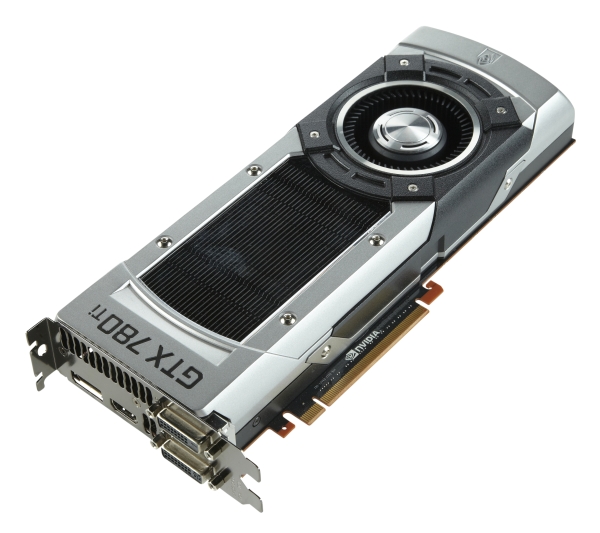Index


Review: Nvidia regains throne, but at a price
Nvidia’s Kepler architecture has been around for a while. Kepler was officially launched in March 2012 and became known as the Geforce 600 series. The top of the line was the GK104-based Geforce GTX 680 card that stood its ground for quite some time. This was a 28nm chip that stayed with us for years and it’s on sale even today in GTX 760 / 770 based mainstream cards.
Then the world’s attention shifted to the GK110, a massive new chip that was announced at Computex 2012 and finally released in November 2012 as the Tesla K20 compute card. This one was based on a brand new, 7-billion transistor GK110 28nm core. It was and still is the biggest GPU even made.
The gaming world met this card in late February 2013 as it debuted as fastest graphics card ever, the Geforce GTX Titan. Titan has 6GB of GDDR5 memory, 2688 Shader processors, 224 texture mapping units and 48 ROPs or render output units. The card is clocked at 837MHz base clock and 876 MHz boost clock and until few weeks ago was the fastest kid on the block. The problem was the $999 price which was enough to burn a huge hole in most wallets.
In May Nvidia launched a cheaper version of the GK110 as the Geforce GTX 780 that came with 3GB of memory, 2304 Shaders 192 texture mapping units (TMUs) and 48 ROPs or Render output units – and it debuted at a much more attractive price of $649 price. AMD launched its now famous Never Settle bundles and fought this card with bang for buck, as its HD 7970 was doing fine, but still ending significantly slower than the huge GK110.
GK110 is made out of clusters and Titan has 14 clusters each having 192 Shader cores. The Geforce GTX 780 has 12 of these cores enabled resulting with 2304 Shader units and the new comer Geforce GTX 780 Ti comes with a record number of 2880 shades, which translates to 15 clusters enabled. You should see CK110 clusters as Borg hives.
The Geforce GTX 780 Ti was something that Nvidia was working on for a while and it decided to release it only when it had enough time to study the new AMD flagship, the $549 Radeon R9 290X based on the new Hawaii chip.
In most cases the Radeon R9 290X its Uber noisy mode ended up faster that the Geforce GTX 780, but also faster than the $999 Titan. Nvidia’s response was to slash the GTX 780 price by $150 and launch the Geforce GTX 780 Ti that will apparently be enough to fight the R9 290X. Nvidia insisted that it has a better cooler, that it can keep the temperature down, but we will get to that later in the review.
The GTX 780 Ti has 25 percent more cores than the original GTX 780 and it has the same size as any GK110 chip, 533 mm2. It needs 250W which translates to 0.47 W per mm2 and it optimally works at 83 Celsius, so says Nvidia. We will get back to this in the bench section.
Nvidia has GPU Boost 2.0 that ensures that the graphics card is always running at the highest possible clock and with a massive cooler it should be able to prevent significant fluctuations in operating frequencies.
Nvidia also added Shadowplay, its automatic game recorder that comes with Geforce Experience 1.7 and higher, Shield PC streaming as well as G-Sync readiness. These new features should help add a bit more appeal to the GK110. G-Sync can synchronize Geforce Kepler cards and your G-Sync capable monitors and will come later this year, with real availability in early 2014. This technology will eliminate frame stuttering and tearing due to a lack of synchronisation between your graphics card and monitor, but it requires a new G-Sync enabled monitor and works only on Kepler cards, GTX 780 Ti included.
Nvidia gameworks, powered by 300 hard working engineers, is working to make games better that result with many classy effects that found their place in modern games. A lot of times Nvidia engineers under Toni Tamasi SVP of content and technology and Asu Rege Vice President, Game Content and Technology, come up with new effects that game developers later implement in these cool games.
To name a few Splinter Cell Blacklist has DX11, tessellation, TXAA and HBAO+, Batmen Arkham Origins has GPU PhysX, DX 11, HBAO+, Tessellation, TXAA, Enhanced 4K, Call od Duty Ghost has DX11, GPU PhysX and tessellation, Watchdog has DX11, tessellation, TXAA and HBAO+ and enhanced 4k, Assassin's Creed Black Flag has DX11, Tessellation, TXAA and HBAO+, God Rays and Enhanced 4K and finally Witcher 3 Wild hunt supports GPU PhysX, DX11,tessalation, FXAA and HBAO+. Nvidia thinks that this is the way it's meant to be played and we cannot forget the fact that Battlefield 4 went to AMD.
Geforce GTX 780 Ti comes with free downloadable copies of Assassin's Creed IV: Black Flag, Batman: Arkham Origins, and Splinter Cell Blacklist from participating retailers and e-tailers. You also get a voucher for $100 off the $299 Nvidia Tegra 4 based Shield gaming console, but the offer is valid only for two more weeks and expires on November 21st 2013.
The card itself looks very similar to the plain Geforce GTX 780, it has a similar cooler, in the dark it glows green like a Fukushima tuna and this can even be adjusted in the driver.
The GK110-425-B1 that powers the GTX 780 TI has 5 graphics processing clusters, 15 streaming multiprocessors, 2880 single precision CUDA cores (Shader units), 960 double precision CUDA cores, 240 Texture Units, 48 ROP units.
With all this its base clock is 875MHz and Boost clock or 928MHz, while the memory runs at 7000 MHz effective. The chip has 1536KB of L2 cache and 3072 MB of GDDR5 memory running on a 384 memory bus. The cards total memory bandwidth is 336GB/s, Texture filtering rate Bilinear is 210 Gigatexels/sec. As we said before the chip has 7.1 billion transistors in 28nm and the card has 2 dual link DVI ports, one HDMI port and one DisplayPort.
Of course this is a dual slot card, needs one 8-pin and one 6-pin power connectors and its TDP (thermal design power) is 250W. Nvidia recommends 600 watts PSU of good quality and you can imagine that if you want to plug two of these babies into your motherboard you would need even more. The 250W TDP is an average usage maximum power scenario but in case you use Furmark or some other benchmark that can get the card on its knees, it can even exceed this number and potentially kill this rather expensive card. The card’s thermal threshold is 95 degrees Celsius.
Before we move to test results, let’s also note that the Geforce GTX 780 Ti comes with Assassin's Creed IV: Black Flag, Batman: Arkham Origins, and Splinter Cell Blacklist, $100 of Nvidia Shield and its suggested retail price is set at $699.
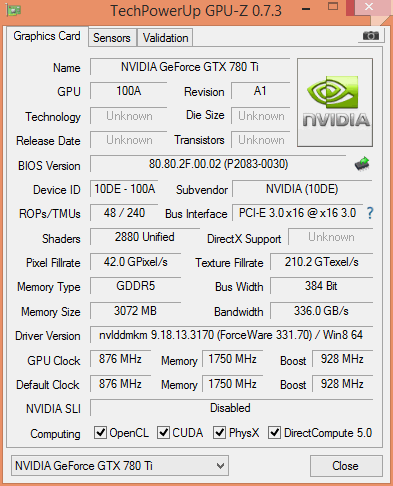
The GTX 780 Ti card is 26.5cm long and 11cm tall. It is a dual-slot design, which is nothing surprising as the cooler design resembles the GTX Titan. On the upper side we see the GeForce GTX logo with LED backlighting, which was also used on the GTX 690 / GTX Titan and GTX 780.
The cooler sports a silver aluminum casing for the cover and a polycarbonate window. Through the window you can see the heatsink. The secret to good cooling is a good vapor chamber design, which also allows engineers to come up with compact yet powerful heatsinks that don’t have tons of heaptipes sticking out of them.
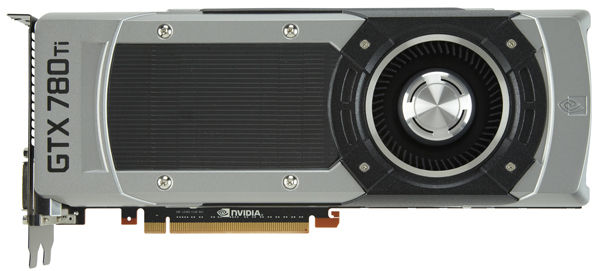
The fan management is great, so the 75mm fan seems rather docile and won’t surprise you with sudden rpm changes. Nvidia’s Boost technology has matured and version 2.0 takes care of things admirably. The GPU temperature threshold is set at 85 degrees Celsius and the card overclocks automatically until the temperature reaches the threshold, provided the load and power consumption readings are not already maxed out. Note that for the GTX 780 the temperature threshold is set at 80 degrees Celsius
During auto-overclocking the temperature could be kept within the 85C envelope by accelerating the fan, but Nvidia wanted to keep things quiet, so Boost 2.0 tends to reduce the GPU Boost clock instead of speeding up the fan. Users who place an emphasis on low noise should like this approach, but performance freaks might want a bit more. We will demonstrate that it’s possible to get better results simply by revving up the fan, without manual GPU overclocking.
There are no memory modules at the back of the PCB since the GTX 780 Ti has 3GB of memory rather than 6GB used on the Titan.
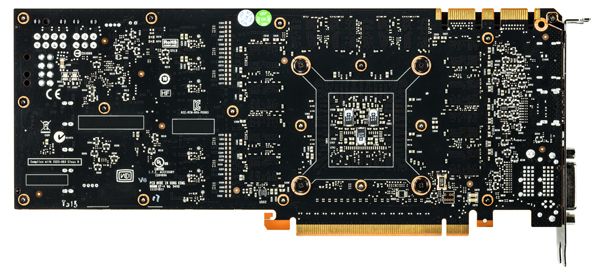

As far as video outs go, most users will have nothing to complain about since the card features two dual-link DVIs, 1.4a compatible HDMI and DisplayPort. Note that all four video outs can be used simultaneously. Nvidia included an HDMI sound device within the GPU, so there is no need to connect the card to your SPDIF out to get audio and video via HDMI.
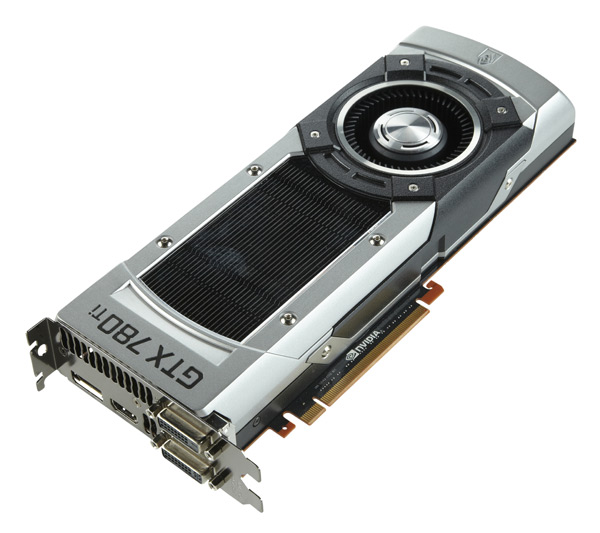
The GTX 780 ships ready for multi-GPU action. In addition to standard dual-SLI, it can also be used in triple- and quad-SLI setups, as it features two SLI connectors. The fact that this is a reference dual-slot design also helps.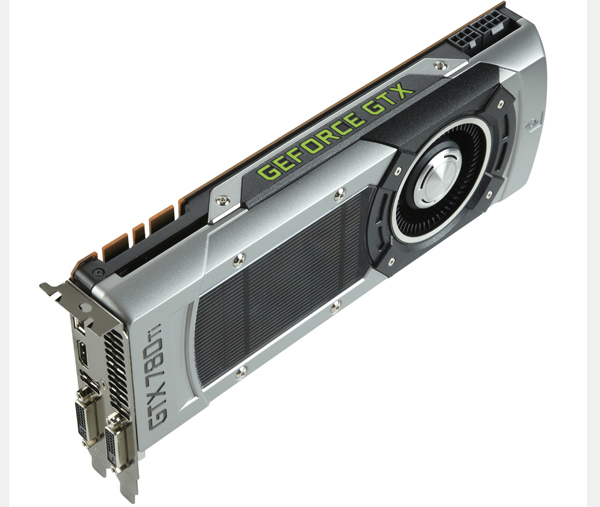
A combination of 6-pin and 8-pin power connectors is used on the GTX 780 Ti. The GTX 780 Ti, GTX 780 and Titan have a TDP of 250W, although we expect the GTX 780 Ti to consume a bit more than the GTX 780.
We applied the same methodology we used in our R9 290X tests, which means we heated up the cards before we started running game tests.
First of all we should not that we tested the R9 290X with the Über BIOS, which is clearly stated in the charts. In Über mode the R9 290X is roughly 6 to 10 percent faster than with the normal BIOS, although the gains vary depending on how hot the GPU actually is. We wanted to pit the latest NV and AMD flagships on a level playing field, so we chose the R9 290X in Über mode.
As you probably know by now, the Über BIOS makes the fan run faster, ensuring better cooling and better performance – but it also means the card ends up noisy, almost too noisy. The R9 290X in Über mode is not the loudest graphics card we ever came across, but it is the loudest card in the current generation, especially when compared to the GTX 780 Ti, which is relatively quiet. Even with the standard BIOS the R9 290X ends up a bit louder than the GTX 780 Ti.
The standard R9 290X BIOS caps the fan speed at 40% RPM, which means it doesn’t get too loud, but it also means the card can’t exploit its full potential. With the Über BIOS the fan speed can go up to 55%, ensuring higher performance and plenty of noise. We hope AMD partners will soon get the green light to roll out non-reference versions of the card with custom coolers, as they would make a lot of sense. That is another reason why we chose to test the R9 290X in Über mode, as it is simply more representative of upcoming custom cards.
However, AMD is not alone in coping with thermal issues, as the GTX 780 Ti also loses its edge when it gets too hot. But Nvidia guarantees the GPU clock will never drop below the base clock, whereas there is no such guarantee with the R9 290X. What’s more, the top 1000MHz clock for the R9 290X is only possible until the GPU heats up; our average, after running a few games, was about 850MHz.
To make things a bit more interesting we decided to check the performance of the GTX 780 Ti once the fan is revved up. We did not overclock the card, we just let the Boost engine work its magic after we accelerated the fan to 85%. At this point it was about as loud as the R9 290X with Über BIOS. We expected to get much better results of we maxed out the GPU Boost clock, but there was not much of a difference, which means you don’t have to fiddle with the card – it can just be kept in auto mode. This means that the GTX 780 Ti has a virtually ideal ratio of performance, temperature, fan speed and noise. The next two charts show why we got a little better results when we sped up the fan. It is clear that the GPU Boost clock exceeds 1000MHz in many situations and it stays there. There aren’t as many variations as in auto fan mode.
Looking at reference design we can tell that the GTX 780 Ti doesn’t reach its full thermal potential, so Nvidia AIBs could come up with plenty of OC cards and we see a lot more overclocking headroom on the GTX 780 Ti than the R9 290X.
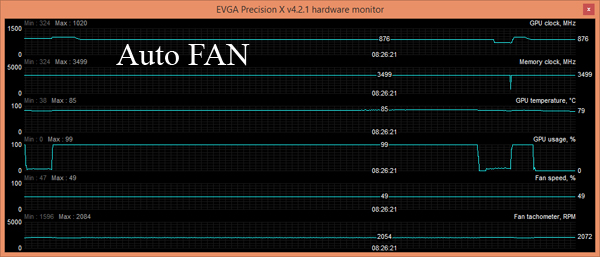
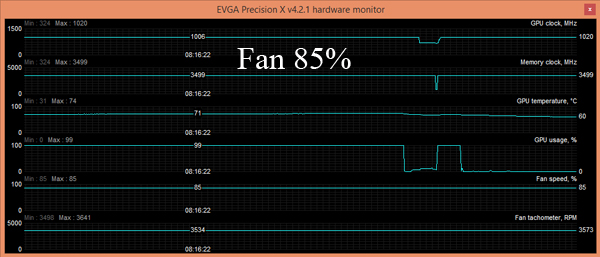
All in all, when we take a closer look at the scores, we can safely say that the GTX 780 Ti is a card that will ensure top notch gaming. We did not have a chance to test a faster and better rounded card yet. However, the R9 290X with the Über BIOS takes a clear lead in several titles, but the GTX 780 Ti is faster in others. The R9 290X is a lot louder, but it is cheaper, too.
The AMD R9 290X was tested with the 13.11_betav8 driver, while the GTX 780/ 780 Ti / Titan were tested with the 331.70 beta drivers. New drivers and a superior custom cooler could give AMD’s card a slight advantage, but the same is more or less true of the GTX 780 Ti.
As far as performance goes, let’s look at how the GTX 780 Ti compares to the plain GTX 780. In some games the difference is very big, up to 27 percent, but in other titles, especially on lower resolutions, the difference is just 4 percent. It ends up faster than the GTX Titan as well, up to 13 percent in some cases.
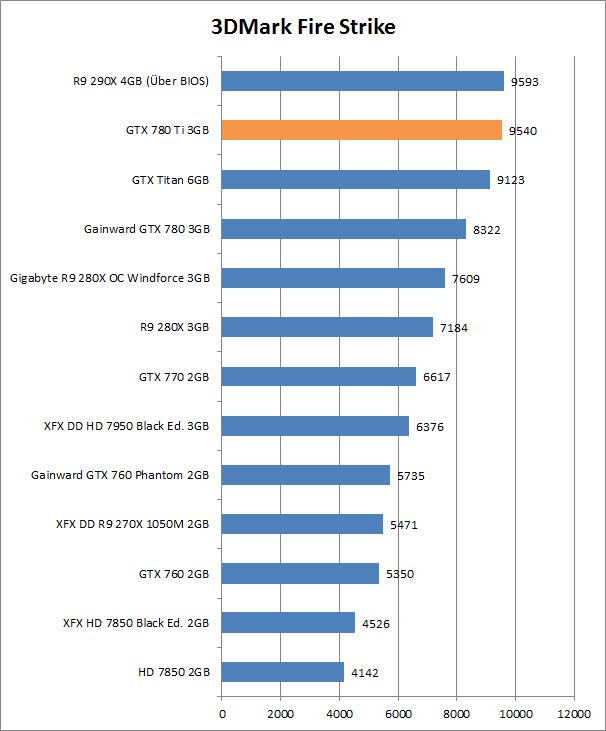
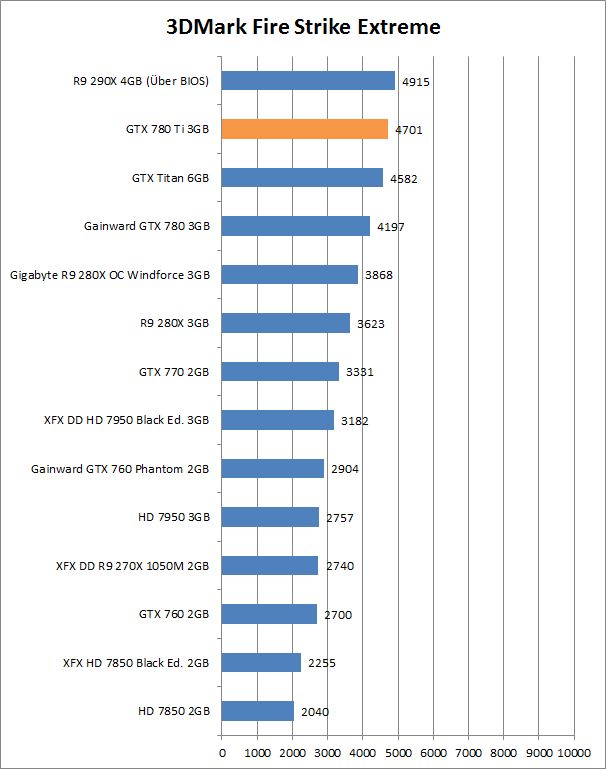
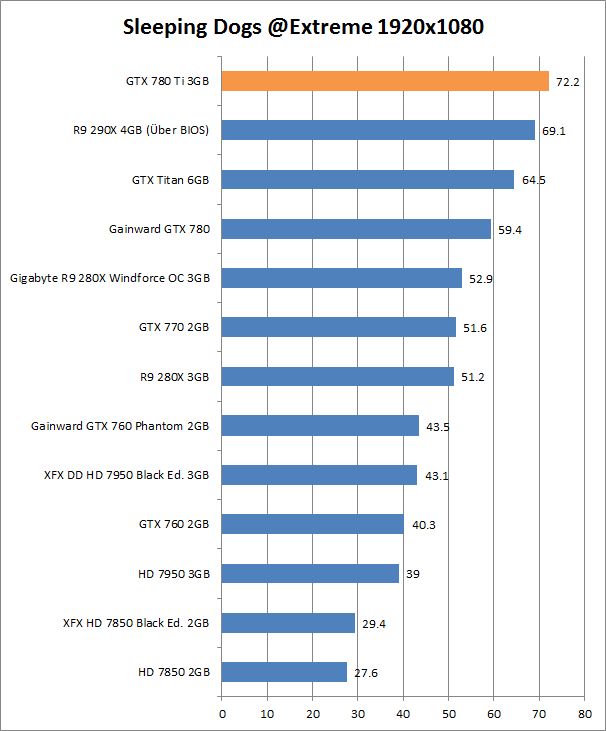
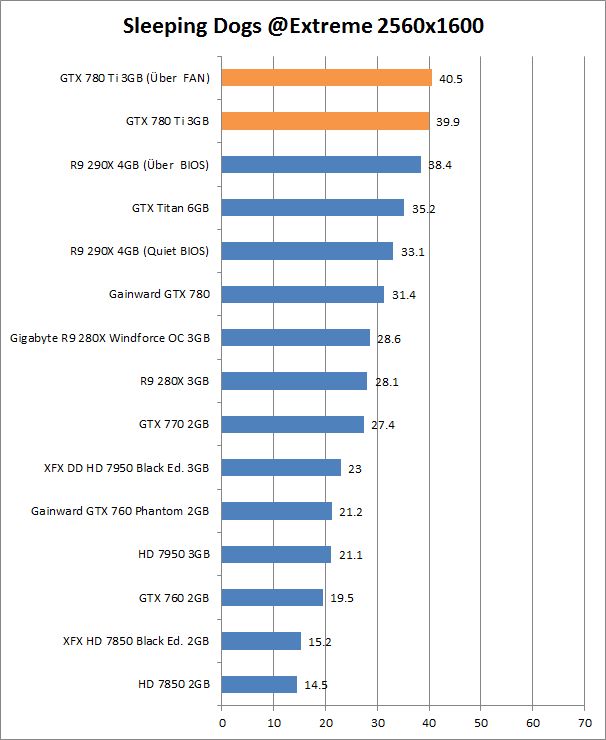
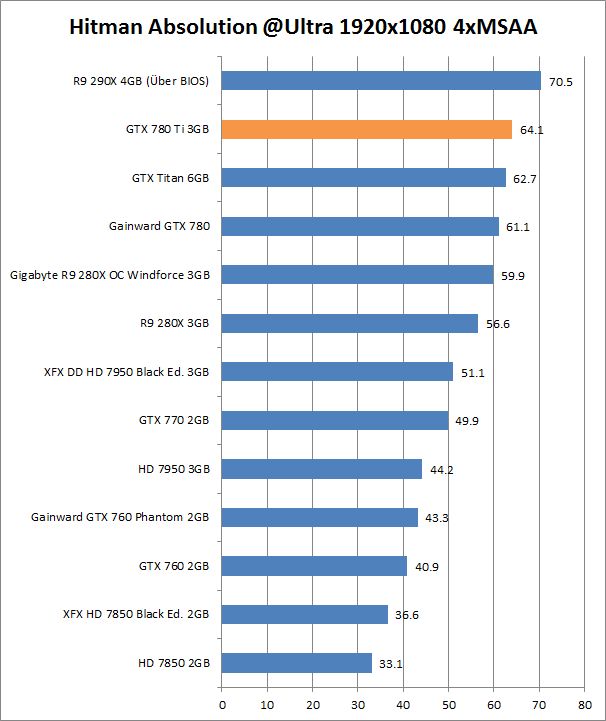
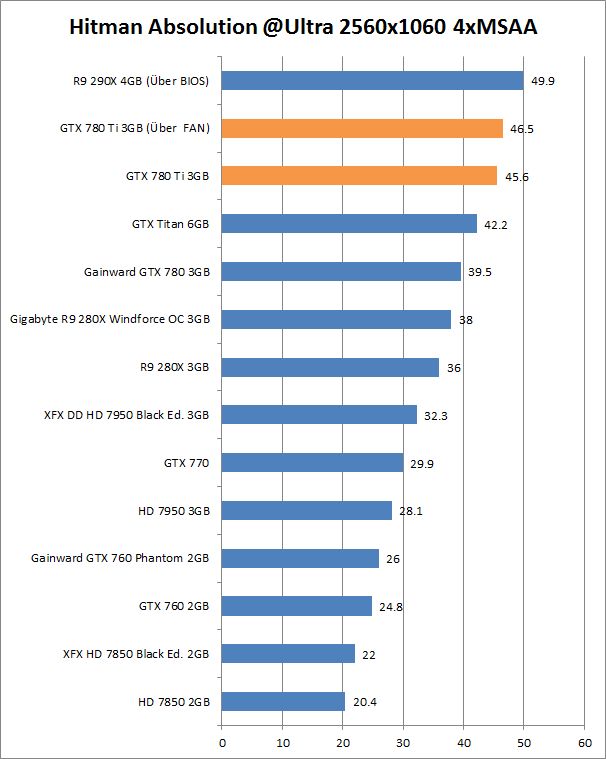
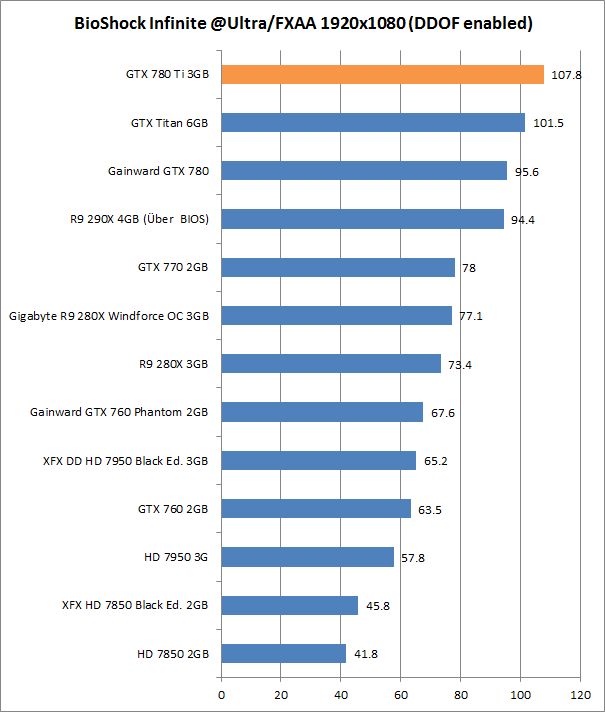
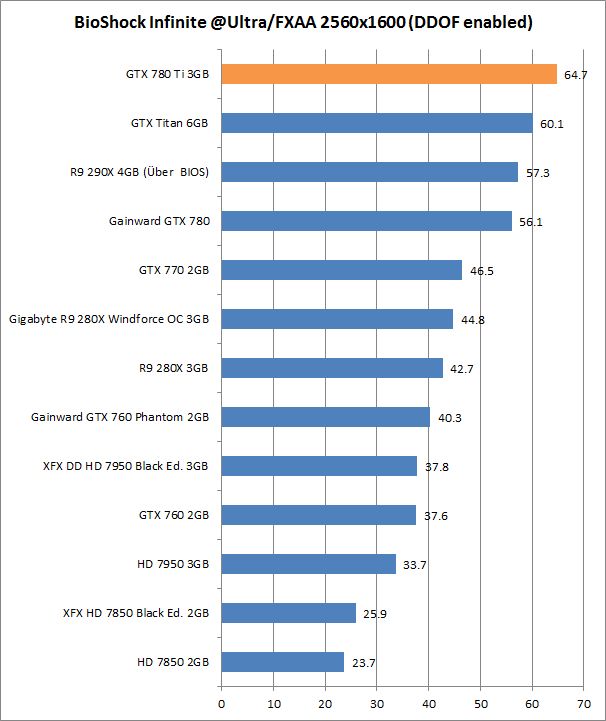
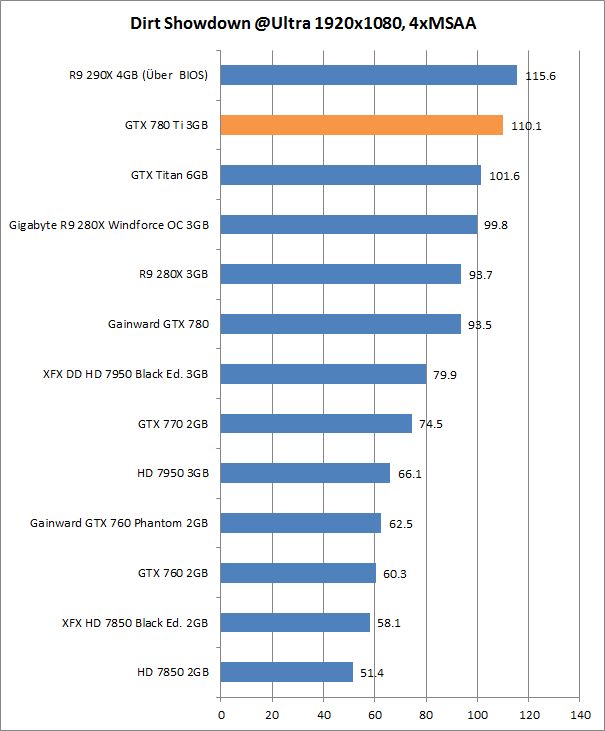
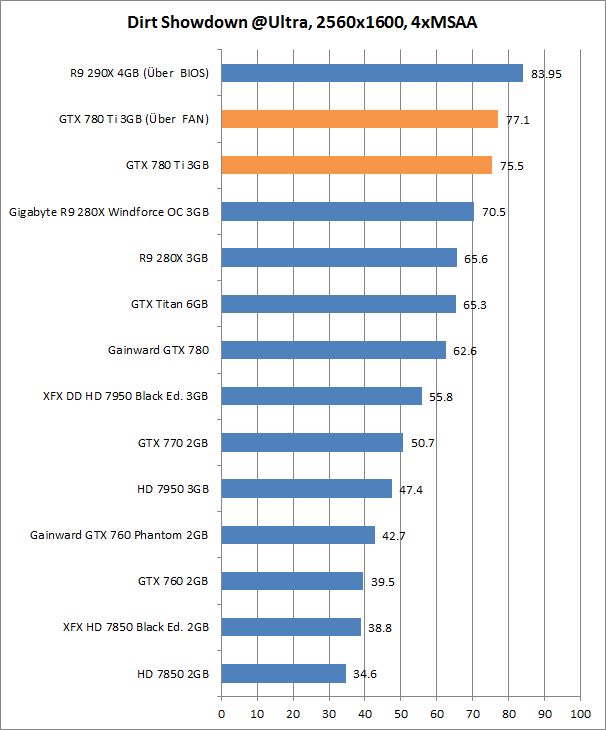
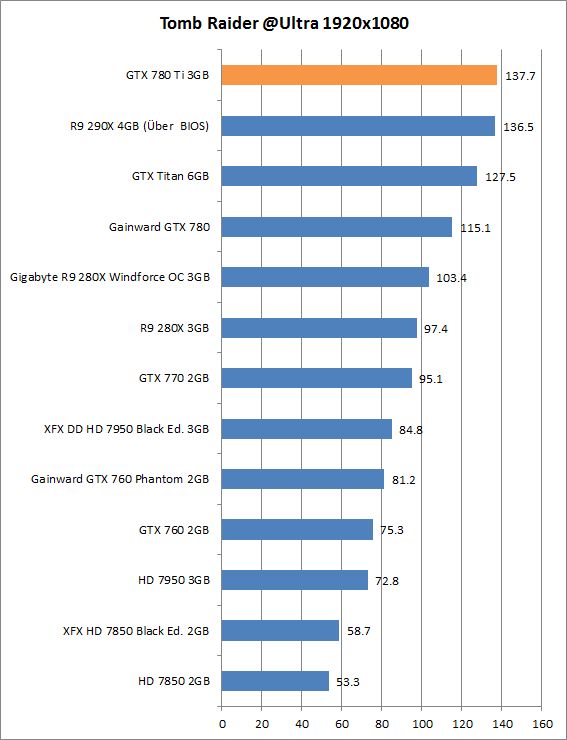
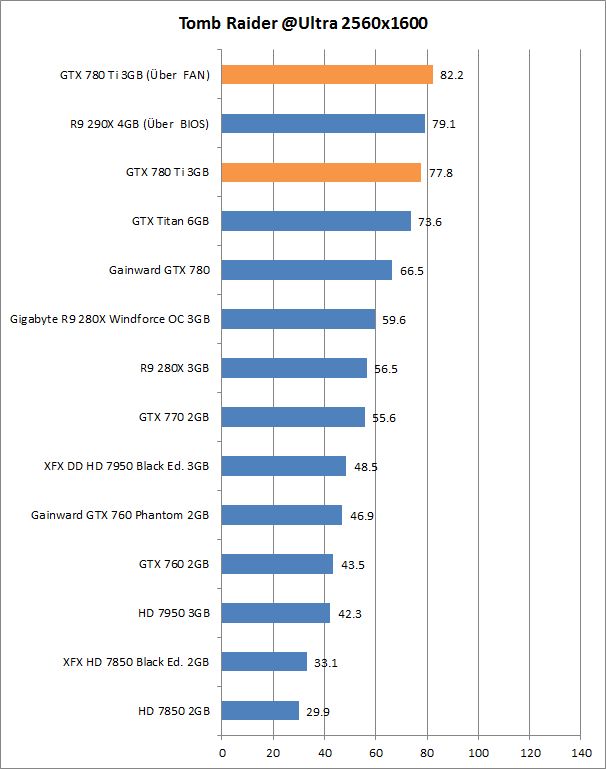
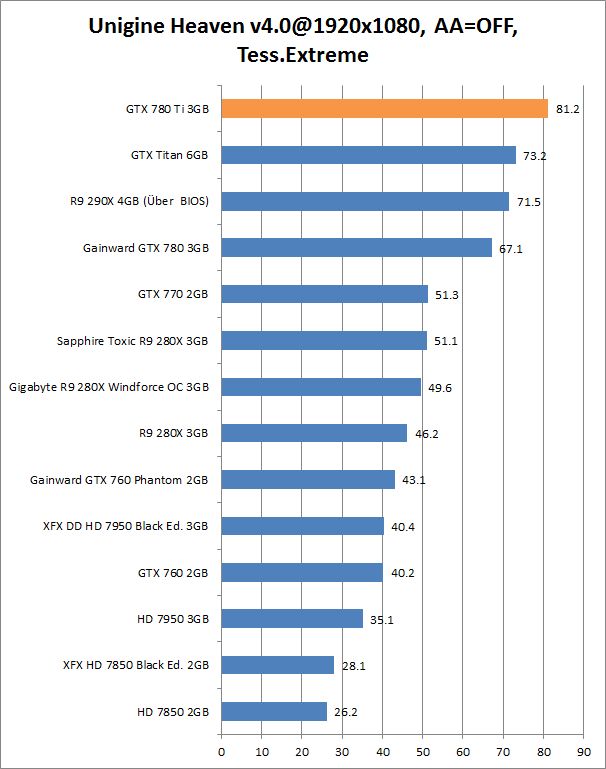
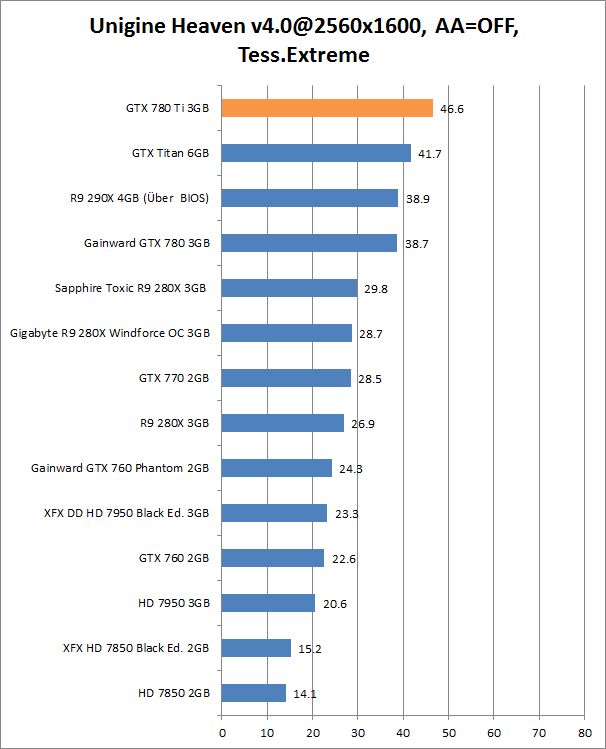
Nvida decided to use practically the same cooler used previously on the GTX Titan and GTX 780, what is a good thing. We already had a chance to get acquainted with Nvidia's reference GTX Titan/780 cooler and we found it being adequate for cooling the massive GK110 chip. The cooler was designed to provide superior cooling performance, but generate less noise than previous Nvidia reference coolers. We can confirm that this is also true of the GTX 780 Ti graphics card, the reference cooler is very good indeed.
The GK110-425-B1 chip used on the GTX 780 Ti is in its core the same as chip used for the GTX 780 but it comes with more shaders and a slightly higher GPU clock; 2880 cores and 875MHz Base clocks compared to the GK110 chip on the GTX 780 which features 2304 cores and 863MHz Base clock.
It is perfectly understandable that the GTX 780 Ti heats up a bit more than the GTX 780, but the good news is that the noise level is roughly the same. The GTX 780 Ti cooler is still very quiet and noise is simply not an issue.
The fan management is excellent and the 75mm fan won’t surprise you with sudden RPM changes. You can see how that the fan gradually accelerates when we start a game and slowly decelerates when we’re done gaming.
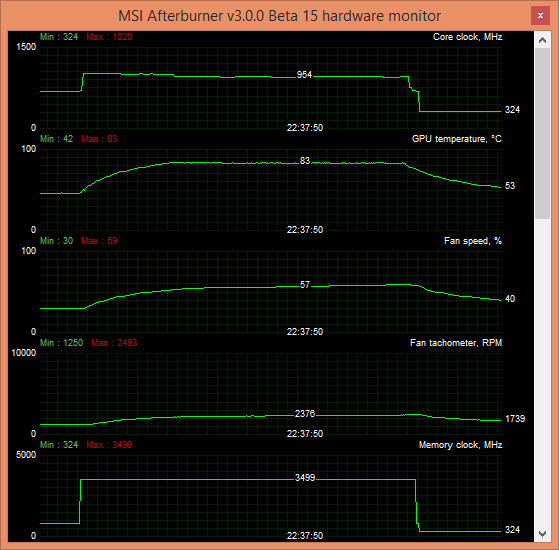
We were wondering what Nvidia did to keep the new card quiet. The cooler is identical to the reference GTX 780 cooler and it was clear that something else was changed. We noticed that the GTX 780 Ti tended to hit 85 degrees Celsius after a bit of gaming. The GTX 780 maxed out on 80 degrees Celsius. Nvidia just changed the max temperature target, trading heat for silence.

Power consumption is on par with the GTX Titan. Max consumption was slightly higher in some cases, but in most situations the GTX 780 Ti didn’t suck as much juice as the Titan. The R9 290X is very close to both cards, so this is really not something to waste time on.
Reaching a conclusion after reviewing a new flagship card is usually easy – they tend to be great and pricey. However, this time around the results are puzzling and a simple and straightforward conclusion is just not something we could come up with.
Despite unleashing the whole potential of the massive GK110 GPU the card has trouble keeping up with the R9 290X in some tests. It’s a case of win some, lose some. One thing is sure – it is certainly not a Radeon R9 290X killer. It runs quieter than AMD in Quiet mode, but it loses in many benchmarks over Radeon R9 290X in Uber mode. In Normal mode, GTX 780 Ti is faster but we can imagine that R9 290X owners will run it in fastest possible way and live with the noise – needless to say enthusiasts will probably get custom cooled R9 290X cards, which could turn the tables around and knock Nvidia’s trump card out if its hands.
The Geforce GTX 780 Ti comes with three games and $100 off Shield and if you are a fan of Nvidia technologies including quite neat Geforce Experience, Shadowplay one click HD game recording, Shield PC stream gaming or G-Sync, this is the card for you. On the other hand, the R9 290X has Mantle and TrueAudio support. However, at $699 it costs significantly more than the Radeon R9 290X but again three games in retail would cost you $150+. It all comes down to what sort of games you’re after and whether you prefer AMD or Nvidia. There’s another issue – at some point AMD could offer Never Settle bundles with the new card.
Bottom line, the Geforce GTX 780 Ti is the fastest Nvidia based graphics card and it will run all games today at great resolutions and high frame rates. If you went for the $999 GTX Titan, it you might not be happy that a card that sells for $200 less is faster, but that’s how it’s always been in the GPU market. Whatever you chose an R9 290X or GTX 780 Ti you will be able to run your favourite games for at least a couple of years, so we’re calling this a tie, although AMD offers better value for money.